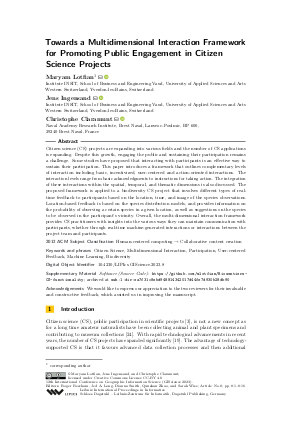LIPIcs.GIScience.2023.8.pdf
- Filesize: 1.79 MB
- 16 pages

 Creative Commons Attribution 4.0 International license
Creative Commons Attribution 4.0 International license

Citizen science (CS) projects are expanding into various fields and the number of CS applications is expanding. Despite this growth, engaging the public and sustaining their participation remains a challenge. Some studies have proposed that interacting with participants is an effective way to sustain their participation. This paper introduces a framework that outlines complementary levels of interaction including basic, incentivized, user-centered and action-oriented interactions. The interaction levels range from basic acknowledgments to instructions for taking action. The integration of these interactions within the spatial, temporal, and thematic dimensions is also discussed. The proposed framework is applied to a biodiversity CS project that involves different types of real-time feedback to participants based on the location, time, and image of the species observations. Location-based feedback is based on the species distribution models, and provides information on the probability of observing a certain species in a given location, as well as suggestions on the species to be observed in the participant’s vicinity. Overall, the multi-dimensional interaction framework provides CS practitioners with insights into the various ways they can maintain communication with participants, whether through real-time machine-generated interactions or interactions between the project team and participants.























Feedback for Dagstuhl Publishing